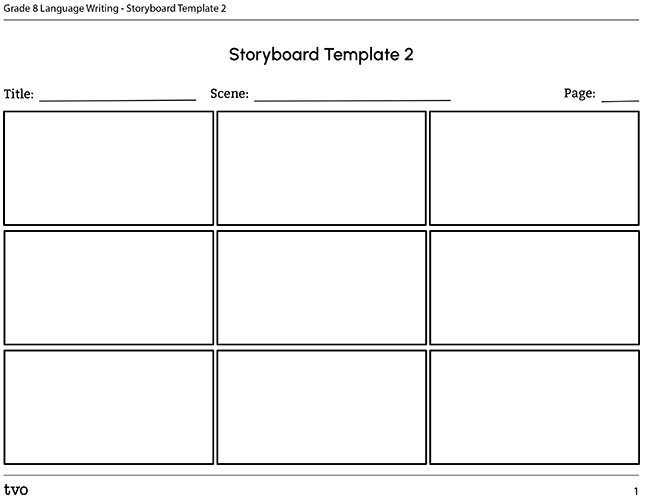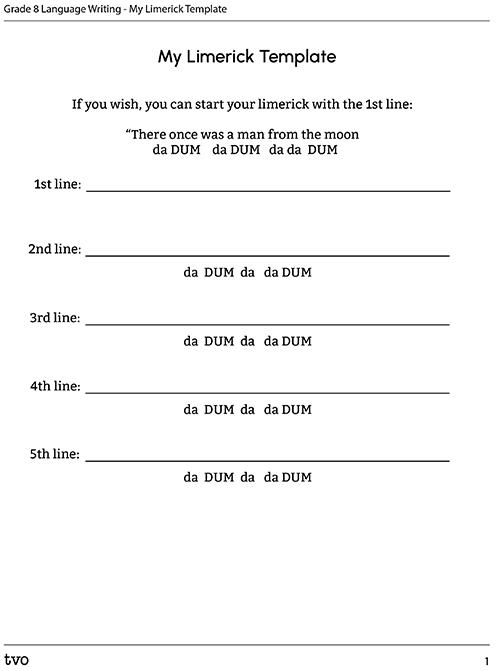Minds On
What is poetry?
Poetry is a written form of expression that helps us to connect with our feelings and thoughts on a subject. It also encourages us to find deeper meaning in our lives. In this learning activity we are going to learn about a type of poetry with five lines i.e. a limerick.
Explore the following untitled limericks
- Limerick #1:
- There once was a Red Maple Leaf
- who flew up and screeched in relief
- was cleared of the charge
- for the fine was quite large
- and knew the mouse was the thief

- Limerick #2
- There once was a pilot named Pan
- who flew to the Isle of Mann
- he came in a storm
- with the wrong customs form
- and had to go back in a van

Action
The Limerick
The limerick is supposed to be entertaining – silly or funny. It tells a very short story, with a subject (character), setting and something that happens.

Limericks
Compare the 1st, 2nd and 5th lines. What do you notice about the rhythm of these lines?
Rhyme pattern 1
Repeat with the 3rd and 4th lines. How does the rhythm of the limerick feel if you clap or tap it out? How would you describe these limericks and their effect on an audience?
Rhyme pattern 2
Example
Discuss your answers with a partner, family member or a friend, if possible, or record your thoughts in a method of your choice.
The limerick has 1 stanza with 5 lines. The endings of the 1st, 2nd and last/5th line rhyme and have a rhythm pattern that has longer stresses or pauses:
ba DUM ba DUM ba ba DUM
2 syllables (the 2nd syllable is stressed or longer than the 1st) 2 syllables 3 syllables (the last syllable is stressed or the longest)
The 3rd and 4th lines rhyme and have a rhythm:
ba DUM ba ba DUM
2 syllables (the 2nd syllable is stressed or longer than the 1st) 3 syllables (the last syllable is stressed or the longest)
For example:
- 1st line:
- There once was a pale pilot named Pan
ba DUM ba ba DUM ba ba DUM - 2nd line:
- who flew to the Isle of Mann
ba DUM ba ba DUM ba ba DUM - 3rd line:
- He came in a storm Pan
ba DUM ba ba DUM - 4th line:
- with the wrong customs form
ba DUM baba DUM - 5th line:
- and had to go back in a van
ba DUM ba ba DUM ba ba DUM
Go over the limericks from the Minds On section to identify the very short story in each one.
Do you notice any familiar literary devices used in the limericks? Explore this short video lesson about personification. Write or share aloud one example of personification from this video.
Press the ‘Story Used’ button to know more about the stories used in the limericks.
Press the ‘Literary Devices’ button to know more about the literary devices used in the limericks.
Simile
Access this short video lesson on simile. Write or share aloud one example of simile from this video.
Try to use simile or personification for an inanimate object to compose 2 or 3 rhyming verses that follow the rhythm pattern of limerick lines 1, 2 and 5: da DUM da DUM da da DUM, and 2 verses that follow the pattern of limerick lines 3 and 4: da DUM da da DUM .
Use brainstorming to start expressing possible words and to find words that rhyme to include at the end of the lines. The focus is to think of and arrange words to get the rhythm of the limerick. Use a thesaurus to help you look for alternatives that might fit the rhythm pattern.
Composing a limerick
Next, try to use the verses to weave a very short story and compose a limerick. It can start off very silly and make no sense. Have some fun making it nonsensical. Try to include similes and personification into your limerick. Try use a storyboard template to see if you find it helpful.
Try using one of the Storyboard Templates in your notebook or use the following fillable and printable document to help you get started.
Next, either take what you’ve composed and adjust your limerick and try to make the very short story make more sense while still retaining some humour and/or entertainment.
Now, try to compose a new limerick that promotes and brings awareness to Earth’s water sources, or the water cycle and/or our individual eco-footprint or a topic of your own choice. Since limericks are supposed to be humorous and entertaining and silly, stay away from any negative stereotypes and/or making fun of someone else’s identity, heritage or any other personal areas like sexual orientation, gender, race/culture/ethnicity, ability, religion, and/or age. Remember treat others as you would like to be treated – with dignity and respect.
Use the My Limerick Template in your notebook or use the following fillable and printable document to help you get started.
If you wish, you can start your limerick with the 1st line:
“There once was a man from the moon
da DUM da DUM da da DUM
2nd line (Blank)
da
DUM da DUM
da da DUM
3rd line(Blank)
da
DUM da da
DUM
4th line (Blank)
da
DUM da da
DUM
5th line (Blank)
da
DUM da DUM
da da DUM
Use a thesaurus to help you look for alternatives that might fit the rhythm pattern.
Give your limericks a title. If possible, conference with your teacher for content before you edit for word choice and proper spelling. Limericks don’t need to follow conventional punctuation or grammar in sentences.
Reflection
How did your understanding of the structure of a limerick as well as the videos on personification and simile help you when creating your limerick?
Consolidation
Purpose of the limerick
How do you think the rhythm pattern of the limerick supports the purpose of the limerick?
Make it meaningful
Reflect upon the message in your limerick written in the Action section which promotes and brings awareness to Earth's water sources, or the water cycle and/or our individual eco-footprint or a topic of your choice.

Respond to this question by expressing your opinion in a short opinion paragraph.
Even though the definition and accepted purpose of the limerick is to be silly, non-sensical and entertaining, do you think it makes sense to write a limerick with a serious message like global warming? Do a bit of research on the limerick form. Explain your opinion.
Reflection
As you read the following descriptions, select the one that best describes your current understanding of the learning in this activity. Press the corresponding button once you have made your choice.
I feel...
Now, expand on your ideas by recording your thoughts using a voice recorder, speech-to-text, or writing tool.
When you review your notes on this learning activity later, reflect on whether you would select a different description based on your further review of the material in this learning activity.


